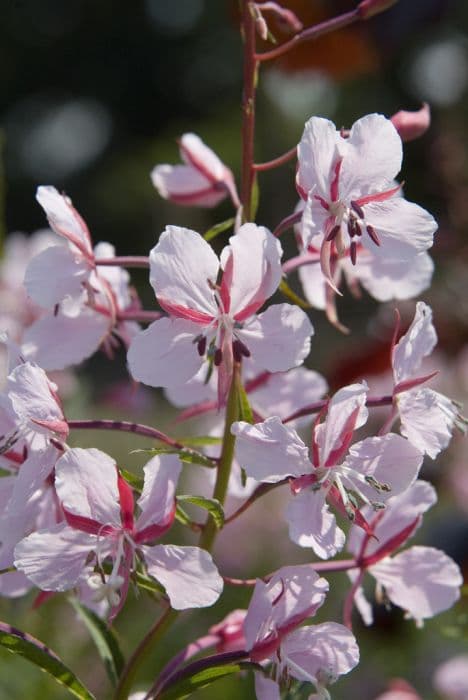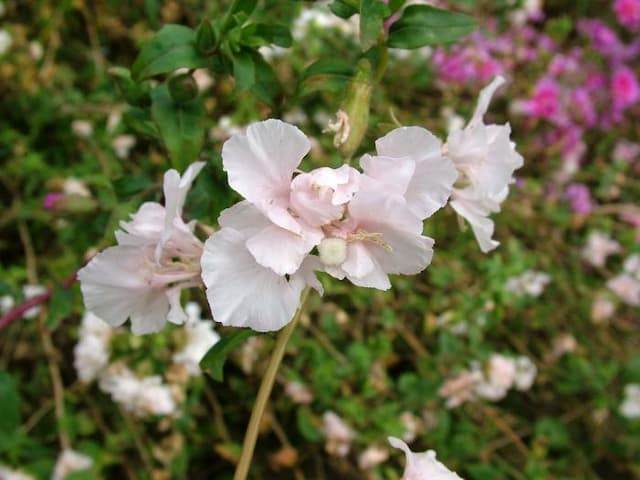Fuchsia Fuchsia 'Baby Blue Eyes'

ABOUT
Fuchsia 'Baby Blue Eyes' is a stunning ornamental plant known for its signature hanging blooms that provide a spectacular display of color. Each flower is a delicate teardrop shape comprising a purple or pink outer layer with a softer lavender or nearly white corolla, dramatically contrasted by long, slender sepals that dangle above the petals. The sepals often appear in a striking, vibrant pink or rich purple color. The blossoms, which recur throughout the blooming season, are a favorite for attracting hummingbirds. The foliage of 'Baby Blue Eyes' is lush, with leaves that have a slight sheen. The leaves are typically a deep green hue, forming an attractive backdrop that makes the vivid blossoms stand out even more. The texture of the leaves is slightly veined, giving them a subtle texture that complements the smoothness of the flowers. The overall form of the plant is gracefully arching, with its branches often bending under the weight of the blooms, creating a cascading effect that is particularly enchanting in hanging baskets or elevated planters where the drooping nature of its blooms can be fully appreciated. This trailing habit also makes it a perfect choice for gardeners who wish to add vertical interest or to soften the edges of containers. The delicate interplay of colors and elegant form of 'Baby Blue Eyes' make it a popular addition to many gardens, where it offers a splash of cool color and a romantic aesthetic.
About this plant
 Names
NamesFamily
Onagraceae
Synonyms
Lady's Eardrops, Fairy Fuchsia, Hummingbird Fuchsia
Common names
Fuchsia 'Baby Blue Eyes'
 Toxicity
ToxicityTo humans
Fuchsia 'Baby Blue Eyes', commonly known as fuchsia, is generally considered non-toxic to humans. However, consuming any part of the plant in large quantities may potentially cause mild gastrointestinal discomfort such as nausea, vomiting, or diarrhea.
To pets
Fuchsia 'Baby Blue Eyes' is also commonly known as fuchsia and is generally considered non-toxic to pets. However, as with humans, ingestion in large quantities could potentially lead to mild gastrointestinal upset in some animals, causing symptoms such as vomiting or diarrhea.
 Characteristics
CharacteristicsLife cycle
Perennials
Foliage type
Deciduous
Color of leaves
Green
Flower color
Pink
Height
1-2 feet (0.3-0.6 meters)
Spread
1-2 feet (0.3-0.6 meters)
Plant type
Shrub
Hardiness zones
9
Native area
Central and South America
Benefits
 General Benefits
General Benefits- Ornamental Appeal: Fuchsia 'Baby Blue Eyes' has delicate, pendant-like flowers that enhance the aesthetic of gardens and landscapes.
- Hummingbird Attractant: The vivid blossoms attract hummingbirds, providing natural pollination and bird-watching opportunities.
- Shade Tolerance: This plant can thrive in partly shaded areas, making it suitable for spots in the garden that receive less sunlight.
- Container Gardening: Fuchsia 'Baby Blue Eyes' is well-suited for containers or hanging baskets, adding versatility to its placement.
- Continuous Blooming: With proper care, the plant can produce blooms from late spring to early fall, offering a long season of visual interest.
- Color Contrast: Its flowers provide a striking color contrast against the green foliage, making it an excellent choice for creating vibrant garden displays.
 Medical Properties
Medical PropertiesThis plant is not used for medical purposes.
 Air-purifying Qualities
Air-purifying QualitiesThis plant is not specifically known for air purifying qualities.
 Other Uses
Other Uses- Fuchsia can serve as inspiration for artists and designers, especially those looking for vibrant color palettes and unique petal shapes.
- The pendulous flowers of the fuchsia make it a favorite subject for botanical illustration and photography, often used in workshops and classes.
- As an edible flower, some species of fuchsia provide decorative garnishes for salads, desserts, and drinks, adding a splash of color and a slightly acidic flavor.
- Dried fuchsia flowers can be incorporated into potpourri mixes, contributing their shape and color to the decorative blend.
- Fuchsia blossoms can be used in crafting, such as making natural jewelry, where the flowers are dried and preserved in resin.
- Fuchsia flowers are sometimes used in personal care products, like bath bombs and soaps, for their color and as a botanical element.
- Some fashion designers may use the structure and colors of fuchsia flowers as motifs in textile patterns and accessory design.
- In colder climates, fuchsia plants can be grown in containers and brought indoors to serve as colorful houseplants during winter months.
- The plant's vivid flowers attract pollinators, so incorporating fuchsias in a garden can support local bee and butterfly populations.
- Fuchsias can be trained into decorative shapes, such as standards or bonsai, making them a practice plant for horticultural art and topiary.
Interesting Facts
 Feng Shui
Feng ShuiThe Fuchsia is not used in Feng Shui practice.
 Zodiac Sign Compitability
Zodiac Sign CompitabilityThe Fuchsia is not used in astrology practice.
 Plant Symbolism
Plant Symbolism- Gracefulness: Fuchsia plants are often associated with grace due to their delicate, hanging flowers that dance in the breeze like ballerinas.
- Good Taste: The elegant appearance of the fuchsia is also seen as a symbol of good taste and sophistication.
- Confiding Love: Fuchsia flowers are sometimes given to express trust and confiding love, as they are delicate and require careful handling, similar to a tender relationship.
- Ardent Affection: The vibrant colors and energetic growth of the plant can symbolize deep and passionate affection.
- Mutual Understanding: With flowers that appear to be in deep conversation, fuchsia can represent a deep mutual understanding between people.
 Water
WaterFuchsia 'Baby Blue Eyes', commonly known as hardy fuchsia, prefers evenly moist soil and should be watered when the top inch of the soil feels dry to the touch. During the growing season, this might mean watering once or twice a week, depending on climate and weather conditions. Use approximately one to two gallons of water per plant, ensuring the water reaches deeply into the soil to encourage strong root development. Always avoid waterlogging by allowing excess water to drain away, and reduce watering frequency in the winter when the plant is not actively growing.
 Light
LightHardy fuchsia thrives in partial shade to full shade conditions, protected from the intense, direct afternoon sun. The best spot for hardy fuchsia would be a location that receives morning sunlight followed by dappled or filtered light during the rest of the day. This will help the plant produce its vibrant blooms without suffering from sunburn or heat stress.
 Temperature
TemperatureHardy fuchsia performs well in a temperature range of 60 to 70 degrees Fahrenheit, although it can tolerate temperatures down to 50 degrees at night. The maximum temperature the plant can endure without stress is about 80 degrees. Protect hardy fuchsia from extreme cold, as it may not survive temperatures below 32 degrees Fahrenheit without sufficient protection.
 Pruning
PruningPrune hardy fuchsia in the spring to maintain its shape, encourage bushier growth, and remove any dead or damaged wood. Pruning also stimulates the development of new flowering branches. Cut back about one-third to one-half of the previous year's growth, and always use clean, sharp pruning shears for clean cuts. The best time for pruning hardy fuchsia is just before new growth begins in late winter or early spring.
 Cleaning
CleaningAs needed
 Soil
SoilThe best soil mix for the Fuchsia 'Baby Blue Eyes' is a well-draining, loamy soil with a high presence of organic matter to retain moisture while avoiding waterlogging. The soil pH should be slightly acidic to neutral, ranging from 6.0 to 7.0 to promote optimal growth and flowering.
 Repotting
RepottingFuchsias, including 'Baby Blue Eyes', should typically be repotted every two to three years. This ensures they have fresh soil and enough room to grow. However, if the plant is growing vigorously, yearly repotting may be necessary.
 Humidity & Misting
Humidity & MistingFuchsia 'Baby Blue Eyes' thrives best in environments with high humidity levels. An ideal range would be around 60-70%. These conditions simulate their natural habitat and help to keep their lush foliage and vibrant flowers in prime condition.
 Suitable locations
Suitable locationsIndoor
Bright indirect light, high humidity, protect from drafts, cool temperatures.
Outdoor
Part shade, shelter from strong winds, keep soil moist, mulch to retain moisture.
Hardiness zone
9-11 USDA
 Life cycle
Life cycleThe Fuchsia 'Baby Blue Eyes', commonly known as hardy fuchsia, begins its life cycle when its seeds germinate in moist, well-drained soil with partial shade to full sun exposure, emerging as seedlings. As the plant matures, it develops a bushy structure with oval, green leaves and distinctive, dangling flowers that are typically pink and violet. These flowers attract pollinators such as hummingbirds and bees, facilitating the fertilization process. After pollination, the flowers form berries that contain seeds, completing the reproductive stage. Throughout the growing season, the plant goes through vegetative growth, blooming from late spring to early fall. In temperate regions, fuchsias die back to the ground during winter, entering a dormancy period, and regrow the following spring, continuing their perennial cycle.
 Propogation
PropogationPropogation time
Spring-Early Summer
Fuchsia 'Baby Blue Eyes' is typically propagated through softwood cuttings, a popular method for many fuchsias. This process is best done in late spring to early summer when the plant is actively growing and the stems are flexible but not too woody or immature. Taking a cutting approximately 2-4 inches (5-10 cm) in length, remove the lower leaves and dip the cut end into rooting hormone to enhance root development. Plant the cutting in a well-draining soil mix, ensuring that at least a couple of nodes where the leaves were removed are buried as these are areas where roots can develop. Keep the soil consistently moist and place the cutting in a warm area with indirect light. After a few weeks, roots should form, and the cutting can eventually be transplanted into its own pot or garden location.









